Half a century with Mars. On November 27, 1971, the first ever spacecraft reached Mars
On November 27, 1971, the surface of Mars reached the first in stories artificial space object. It was a descent vehicle from the Soviet automatic interplanetary station (AMS) "Mars-2". Although the craft crashed on landing, it became the first lander in history to reach the surface of the red planet. For humanity, which dreamed of studying the planets of the solar system, this was a huge step forward.
Despite the partial success of the mission, the event that took place half a century ago, on November 27, 1971, forever entered the history of Soviet and world cosmonautics, becoming an important achievement and record.
This was preceded by the colossal work of Soviet designers and engineers, the quintessence of which was the six-month flight to Mars of an automatic interplanetary station.
Space program "Mars"
The Soviet automatic interplanetary station "Mars-2" went to the red planet about a month before the birth of Elon Musk, who today is practically the main adept in the study and colonization of Mars. Two backup stations "Mars-2" and "Mars-3", which were no different from each other, were launched from the Baikonur cosmodrome on May 19 and 28, 1971, respectively.
At the same time, a space program called "Mars", which includes the construction of automatic stations of the same name, was carried out in the USSR from 1960 to 1973. The main goal of the program was to study both the planet itself and the near-planetary space of Mars.
The designers of OKB-1 (today the SP Korolev Rocket and Space Corporation Energia) were responsible for the development of the first generation AMS "Mars". The designers of the Lavochkin NPO were already responsible for the creation of the third and fourth generations of the Mars stations. Automatic interplanetary stations "Mars-2" and "Mars-3" belonged to the spacecraft of the fourth generation.
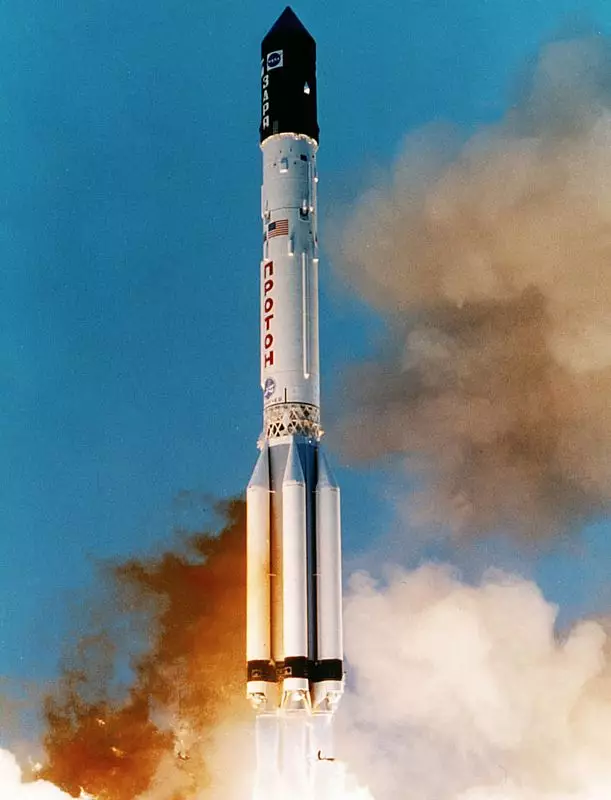
Heavy launch vehicle "Proton-K" module "Zarya" for the ISS, November 20, 1998, photo: wikimedia.org
The implementation of such a large-scale and innovative project required the creation of a special infrastructure.
A radio-technical complex for long-range space communications was built in the country especially for the first launches of spacecraft to Mars. In addition, a 2,6-meter telescope located at the Crimean Astrophysical Observatory was supposed to follow the flight path of the first station.
Special missiles were also required to launch the AMS.
While the Molniya 4-stage medium-class launch vehicle was used to launch the first and second generation stations, the heavy launch vehicle was used to launch the third and fourth generation stations, the name of which is familiar to almost every Russian today. It was a Proton-K rocket with an additional fourth stage in the form of an upper stage D.
AMC device "Mars-2"
"Mars-2" consisted of an orbital station and a spacecraft descending to the planet. The layout of the automatic station was proposed by the young designer of NPO im. Lavochkin V.A.Asyushkin. The AMC housed two photo-television cameras with different focal lengths. The cameras were supposed to be used to photograph the surface of the red planet and objects on it. Scientific equipment was represented by an infrared radiometer, as well as infrared and ultraviolet photometers.
The Mars-3 spacecraft was additionally housed with scientific equipment called Stereo. It was equipment for a joint Soviet-French project to study radio emission from the Sun at a frequency of 169 MHz.
Structurally, both stations were similar, duplicating each other in case of malfunctions or serious breakdowns. Moreover, each AMC consisted of an orbital compartment and a descent vehicle.
The orbital compartment of the automatic interplanetary station "Mars-2" had the following layout: an instrument compartment, a block of fuel tanks of the propulsion system, a jet engine with an automatic system for adjusting the position in space, a solar battery, radiator thermal control systems, antenna-feeder devices.
AMS "Mars-2" was a real high-tech of its time. The station received the most modern autonomous space navigation system with an optical goniometer, which at that time had no analogues in the world. Orientation in space was carried out simultaneously along the Sun, the Canopus star and the Earth. In addition to the navigation system, the control system included an onboard computer and a gyro-stabilized platform.
The descent vehicle is an automatic Martian station, which was equipped with equipment that ensures separation from the orbital compartment of Mars-2 and the transfer of the compartment to the trajectory of rendezvous with Mars. Externally, the descent module was a conical aerodynamic braking screen that covered the automatic Mars station. An instrument-parachute container was attached to the top of the station, in which the pilot and main parachutes were located, as well as scientific instruments.
On board the descent module was a variety of scientific equipment designed to measure pressure and temperature on the Martian surface, as well as to carry out mass spectrometric analysis of the planet's atmosphere. Also on board was equipment for determining wind speed and chemical-physical, as well as mechanical properties of the surface layer of Mars. To obtain panoramic images from the surface, there were television cameras on board, according to the official website of Roscosmos.
Flight to Mars
On May 19, 1971, the Proton-K heavy launch vehicle was successfully launched at the Baikonur cosmodrome. The rocket set off to conquer space at 19:22:49 Moscow time. The Mars-2 automatic interplanetary station was on board the Proton-K. The station was designed to explore Mars and its near-planetary space.
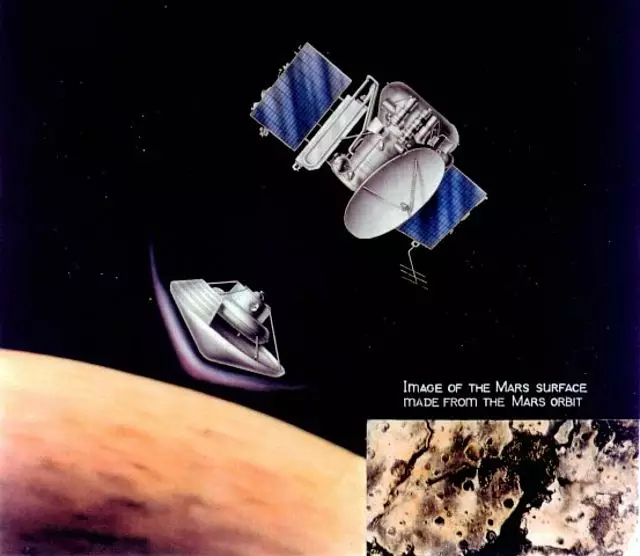
Separation of the descent vehicle from the station, image: roscosmos.ru
Unlike the Soviet automatic interplanetary stations of previous generations, the Mars-2 station was first put into an intermediate orbit of an artificial Earth satellite, after which it was transferred to an interplanetary trajectory by the upper stage D, starting its long and long journey.
The entire flight to Mars, which took more than 6 months, went on as usual.
On June 17 and November 20, 1971, the AMC's trajectory corrections were successfully carried out. Until the very moment of approaching the red planet, the flight took place under the research program. The third correction of the trajectory took place on November 27, 1971, it was carried out in a fully automatic mode without the use of technical means on the surface of the Earth.
The autonomous astroorientation system installed on the Mars-2 spacecraft provided the station's orientation in space and was able to determine the position of the spacecraft relative to the planet under study. The information received was entered into a computer on board the station, after which the computer performed calculations to carry out the correction. After the third correction, the station entered its trajectory, which passed at a distance of 1 kilometers from the Martian surface.
Failure with the descent vehicle
The lander separated from the Mars-2 station on November 27, 1971, when the AMC flew up to the red planet. This happened before the deceleration of the station and its entry into Mars orbit as an artificial satellite. A quarter of an hour after separation, a solid-propellant propulsion system started operating on the descent vehicle. This installation ensured the transfer of the descent vehicle to a trajectory that ensures it hits the Martian surface.
The problem of the mission was the wrong angle of entry into the atmosphere of Mars, which turned out to be more than acceptable values. Because of this, the descent module entered the planet's atmosphere at a very steep angle and did not have time to effectively decelerate during the aerodynamic descent stage. The parachute system installed on the descent module could not work effectively in such conditions, so the apparatus, piercing the Martian atmosphere, crashed against the planet's surface.
Despite the failure, the Mars-2 lander was the first man-made object in history to reach the surface of Mars. The descent module crashed at a point with coordinates 4 ° N. NS. and 47 ° W in the Valley of Nanedi in the Land of Xanthus. It is a vast area of the Martian surface located at the equator.
The reason for the failure of the descent module was the deviation from the calculated values of the trajectory of movement. This deviation is explained by the insufficient level of testing of the material support of the station's on-board computer.
Despite the failure of the descent vehicle, the station "Mars-2" itself successfully entered the Martian orbit, where it worked for 8 months, conducting a variety of scientific research. The AMS operated in an orbit with a minimum distance of 1 kilometers from the Martian surface and a maximum distance of 380 kilometers. The orbital period of the station around Mars was 25 hours. In total, the station made 000 orbits around the red planet.
The TASS agency announced the complete completion of the space flight program on August 23, 1972. By that time, Mars-2 had been operating in the Martian orbit for more than 8 months, continuing research until the nitrogen reserves in the stabilization and attitude control system of the station were completely depleted.
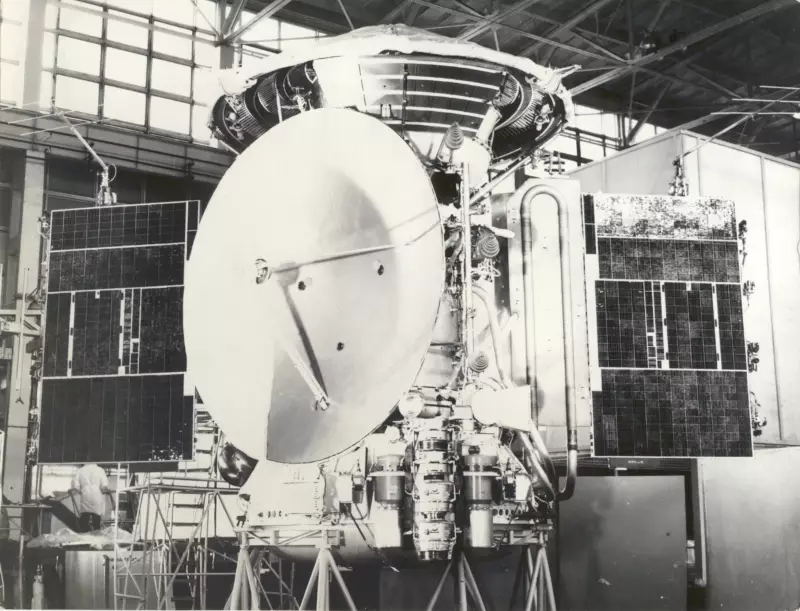
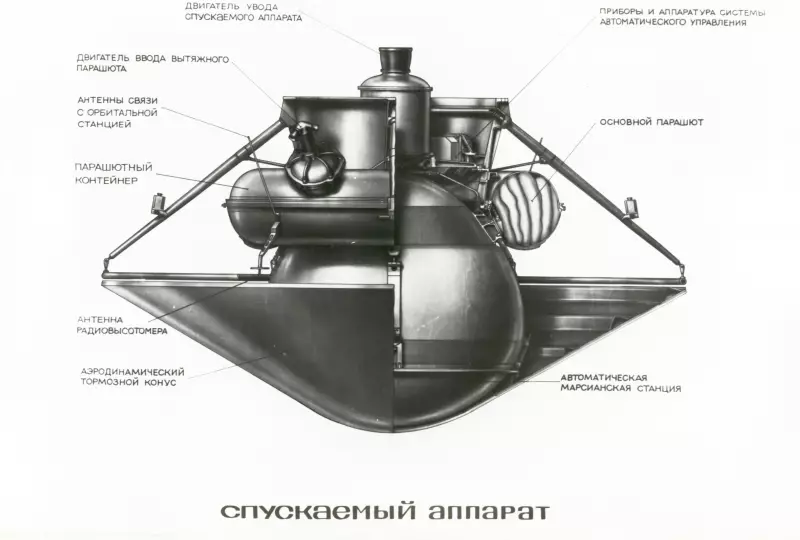
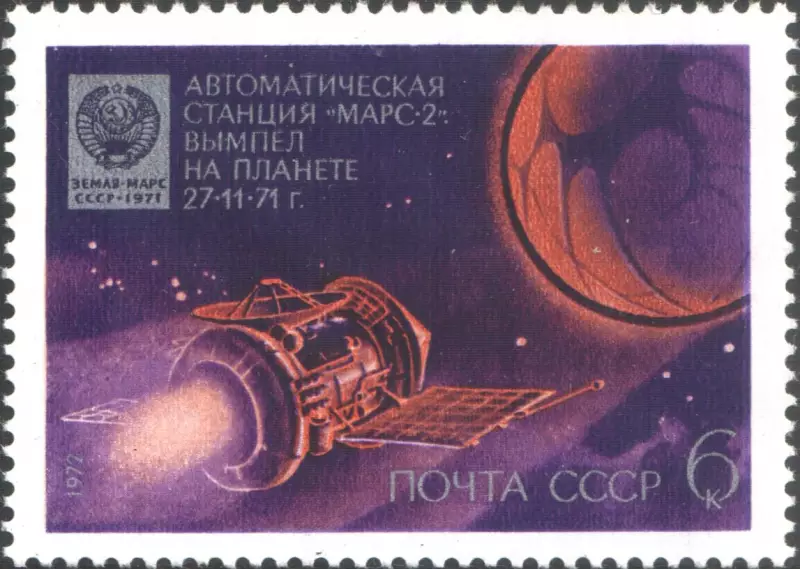
Information